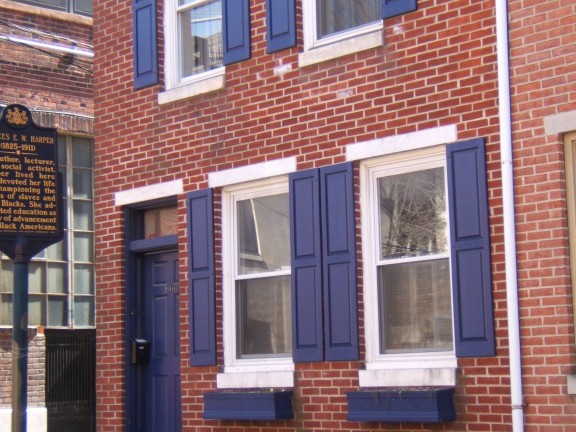Frances Ellen Watkins Harper House

Frances Ellen Watkins Harper (1825–1911), the remarkable Black poet, author, lecturer, and social activist, purchased this house on September 8, 1871, for $2,266.67, and she owned it for the rest of her life. Built in 1845, the house was operated as a multi-occupant “tenement,” and, while living here, she often shared it with relatives.
The original façade was refaced with light-colored brick in 1923, when the ground floor was converted into a store. The ca. 1875 pinnacled cornice was preserved at that time and once more in 1987 when the façade was rebuilt on the model of other small Greek Revival houses on nearby streets.
By the time Harper moved to Bainbridge Street, she was a well-established champion of progressive causes. Born to free Black parents in Baltimore, she was orphaned and raised by her abolitionist aunt and uncle. She began to publish poetry in abolitionist periodicals, and her first small volume of poems, Forest Leaves, appeared when she was in her early twenties.
Harper left Maryland in 1851, first to teach at Union Seminary in Wilberforce, Ohio, and then in York, Pennsylvania. In 1853 she moved to Philadelphia, to live with William and Letitia Still, abolitionists whose home was a station on the Underground Railroad. She continued to publish poetry and began to lecture on social issues, principally slavery, although she also supported women’s rights and temperance. In 1854 she left Philadelphia to lecture on behalf of the Maine and Pennsylvania Anti-Slavery Societies.
While in Ohio in 1860, she met and married Fenton Harper; they had a daughter, and when he died in 1864 she began touring again. Her audience was now emancipated, and her message was at once uplifting and challenging.
It was at this juncture, in 1871, that Harper returned to Philadelphia and bought this house. She spent the second half of her life advocating for racial justice, women’s rights, and temperance. She was co-founder and vice president of the National Association of Colored Women’s Clubs, director of the American Association of Colored Youth, and superintendent of the Colored Sections of the Philadelphia and Pennsylvania Women’s Christian Temperance Unions.
She continued to write prolifically, publishing Poems (1871), Sketches of Southern Life (1872), The Martyr of Alabama and Other Poems (1892), The Sparrow’s Fall and Other Poems (1894), Atlanta Offering (1895), and the novel Iola Leroy or Shadows Uplifted (1892)-- one of the first novels published by a Black woman.
Harper died in 1911 at the age of 86, after a brief illness. She bequeathed 1006 Bainbridge Street to her cousin Emily Mandrucu.